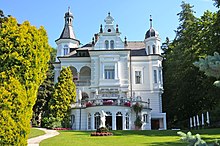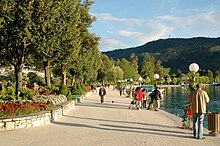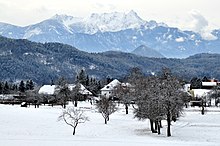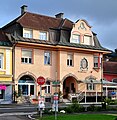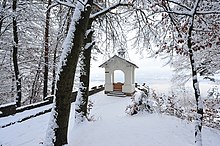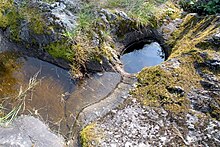Pörtschach am Wörther See
|
Pörtschach am Wörther See
|
||
|---|---|---|
| coat of arms | Austria map | |
|
|
||
| Basic data | ||
| Country: | Austria | |
| State : | Carinthia | |
| Political District : | Klagenfurt-Land | |
| License plate : | KL | |
| Surface: | 12.64 km² | |
| Coordinates : | 46 ° 38 ' N , 14 ° 9' E | |
| Height : | 461 m above sea level A. | |
| Residents : | 2,885 (January 1, 2020) | |
| Postal code : | 9210 | |
| Area code : | 04272 | |
| Community code : | 2 04 24 | |
| NUTS region | AT211 | |
| Address of the municipal administration: |
Hauptstrasse 153 9210 Pörtschach am Wörther See |
|
| Website: | ||
| politics | ||
| Mayoress : | Silvia Häusl-Benz ( ÖVP ) | |
|
Municipal Council : ( 2015 ) (19 members) |
||
| Location of Pörtschach am Wörther See in the Klagenfurt-Land district | ||
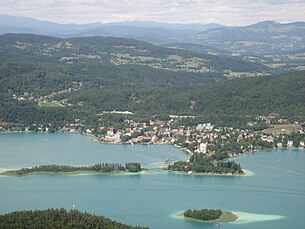 Aerial view of Pörtschach |
||
| Source: Municipal data from Statistics Austria | ||
Pörtschach am Wörther See ( Slovenian Poreče ob Vrbskem jezeru ) is a municipality with 2885 inhabitants (as of January 1, 2020) in the Klagenfurt-Land district in Austria. It is particularly known as a summer vacation spot.
Pörtschach is a legally recognized health resort .
geography
Pörtschach is 446 to 702 meters above sea level on the northern bank of the Wörthersee , about 14 km west of Klagenfurt .
Community structure
The municipality is divided into the two cadastral communities Pörtschach am See ( Poreče ob jezeru ) and Sallach. The only place in the municipality is Pörtschach am Wörthersee. This includes the following districts:
- At the glacier pot
- Goritschach
- Leonstein (ruin)
- Pritschitz (Pričiče)
- Run away
- Sallach
- Windischberg
- Winklern
Neighboring communities
| Moosburg | ||
| Techelsberg |

|
Krumpendorf |
| Maria Wörth |
geology

The landscape of the Wörthersee , on which Pörtschach and Pritschitz lie, was significantly shaped by the last glaciation. During the last Würm Ice Age (around 100,000 BC), the valley furrows of both Lake Wörthersee and the somewhat higher Keutschacher See were therefore completely filled with glacier ice. From the Central Alps, the western Gailtal Alps , the Carinthian Alps and the western Gurktaler Alps huge masses of ice to the east flowed out, and united in space Villach to the mighty Drau glacier with a maximum width of 30 km, at Villach with 900 m height at Klagenfurt yet about 700 m and the end at Bleiburg , Wallersberg, Griffen . The formation of the lake basins mainly took place during the ice retreat. The largest part of Pörtschach is made up of young ice age (or recent) deposits, the mountain chains behind (Hoher Gallin, Bannwald, Gaisückenberge, Sallacher Berg, Pirkkogel) are old crystalline. A remnant of this ice retreat is a boulder with cut marks, the glacier pot.
history
Pre-celtic and Celtic times
The so-called bowl stones, which can still be found in many parts of the country, probably come from the Stone Age . At the intersection of Sankt-Oswalder-Straße and Goritschacher Weg, a bowl-shaped depression is carved into a projecting rock cone about thirty centimeters high. During the cult ceremonies, the offering, probably blood from small animals such as birds or rodentia, was caught in the small recess in the rock.
Antiquity and the Middle Ages
According to findings, the Norische Hauptstrasse from Velden to Krumpendorf already ran through the municipality during Roman times . Around 600 the Slavs founded a settlement, from which the naming is likely to come ("porecah" = "with the people who live by the stream"). Pörtschach was first mentioned in a document in 1150. The Seeburg built during this time no longer exists, apart from the scanty remains of the wall.
The nearby Leonstein Castle has fallen into serious disrepair, but has been restored for several years. Leonstain Castle was built around 1490 in the immediate vicinity of today's town center. Today there is a hotel in it. The castle is owned by the Neuscheller family.
Modern times
The tourist boom came with the first summer visitors in the 19th century, especially after the opening of the Wörtherseeschifffahrt in 1853. Shortly afterwards, in 1864, Pörtschach became a station of the new southern railway from Vienna to Italy, which made the place a popular holiday home. Well-known guests were z. B. Emperor Franz Joseph I , Gustav Mahler and Johannes Brahms . After the boom years of tourism in Carinthia in the 1960s and 1970s, Pörtschach is experiencing a revival as a scene location on Lake Wörthersee. The targeted goal, however, is gentle tourism as a perspective for the future.
population
According to the 2001 census, the community of Pörtschach had 2,670 inhabitants. 90.3% had Austrian citizenship, residents of Croatia (3.0%), Germany (2.3%) and Bosnia-Herzegovina (1.3%) had the largest share of members of foreign nationalities.
For the Roman Catholic Church , 75% of the community population known for Protestant Church 10% and Islam 1.6%. Approx. 10% described themselves as non-denominational.
Culture and sights
Sacred buildings
Evangelical Church of the Savior
Alfred Rinesch built the church between 1956 and 1958, and it was consecrated in 1959. It is connected to the Protestant parish center. You enter a hall building with a transept indicated to the east. The roof turret is equipped with a pointed helmet . The simple church interior has concrete glass windows created by Josef Tichy in 1989 .
Parish Church of Saint John the Baptist
The previous building of the current parish church was mentioned in a document as early as 1328, but an even older baptistery is assumed to be a subsidiary church of Maria Wörth , which was probably on the site of the bathtub, which was demolished in 1907. It has been an independent parish since 1785 . In 1787, today's church was built in place of an older predecessor, the consecration took place in 1794, the tower collapsed in 1891, and from 1904–1906 the facade was enlarged and redesigned according to plans by Josef Viktor Fuchs.
The medium-sized building with a 5/8 end of the choir presents itself in neo-renaissance forms , which is unique in Carinthia , with pilasters and archivolts framed windows and niches with stone figures by Konrad Campidell ; the facade tower shows itself with large, arched sound windows, pointed gables and an onion helmet . This architecture - polychromy dates from 1904/06.
The nave has three aisles, the wall structure is adapted to the exterior; above the cornice is a barrel with stuccoed fields and painted biblical scenes; the aisles are divided by continuous galleries . The brick-built organ loft with three axes rests on pillars. The figural glass windows in the choir date from 1905.
The historical high altar from 1919 is the work of Jacob Campidell , baroque figures Saint Mary and Saint John , above it instead of the central window a painting Christ on the Cross (copy after Van Dyck ) inscribed 1909. Two side altars, 1925 by Jacob Campidell; on the left baroque figure seated Mater Dolorosa and pictures of Saints Anna and Saint Theresa ; on the right figure Saint Anthony of Padua ; Images of Saint Joseph and Saint George 1925 by Adolf Campidell . - The pulpit dates from the same time, labeled renovatum 1956. Organ by Josef Mauracher from Sankt Florian, consecrated in 1906. Two large pictures in the aisles , both with donor inscriptions in 1905; left copy of the Sistine Madonna , right Saint Joseph. Next to the pulpit Coronation of Mary (copy after Velazquez ) inscribed 1914; Way of the cross marked F. Küss pinx. 1876
On October 26, 2008, Bishop Alois Schwarz consecrated the new Mauracher- Eisenbarth -Orgel as part of a festive service . The instrument has 30 stops on two manuals and a pedal . 13 registers come from the previous organ from 1895, which was built by the organ builders Brothers Mauracher (Salzburg). The Spieltrakturen are mechanically, the Registertrakturen electrically.
|
|
|
||||||||||||||||||||||||||||||||||||||||||||||||||||||||||||||||||||||||||||||||||||||||||||||||||||||||||||||||||||
- Coupling : II / I, I / P, II / P
- Playing aids : Electronic setting system with 2000 combinations
- H = register from 1895, completely or partially preserved (Gebrüder Mauracher, Salzburg)
- Rectory:
- The two-storey building with a hipped roof and a simple, late-historical facade structure is east of the parish church. A small extension was made on the south side around 1900. In the years 1986 to 1988 the roof extension and new roofing were carried out, as well as an interior renovation.
- Mesnerhaus:
- The building is located at Moosburger Straße 22 northwest of the parish church. It represents a single-storey, late historical building from the end of the 19th / beginning of the 20th century. On the south and west side there are small niches with paintings, Saint George on the west wall and Saint Florian on the south wall.
Filial church of Saint Oswald
- The Holy Oswald of Northumbria is represented as king with scepter ceremonial vessel and ravens next to him, holding a pin or ring in its beak. He is often assigned to the fourteen Nothelfem. He is the patron saint of reapers and cattle. Oswald was born around 605 as the son of King Ethelfrid. His sister was St. Ebba, who became abbess at the Coldingham monastery he founded and lived a saintly life there. After the death of his father (617), the young prince fled to live with the Scots monks in Lona, where he was taught and baptized in the Christian faith. In 634 Oswald defeated the pagan king Cadwalla at Hexham, he succeeded in driving out the Bretons and recapturing his country. From then on he was primarily concerned with the introduction and consolidation of Christianity. Oswald became engaged to the daughter of the pagan king of Wessex and got his future father-in-law to accept the Christian faith and also to Christianize his country. Oswald gradually gained a kind of supremacy over almost all of England. He had many churches and monasteries built and was distinguished by his humble life. He was also a loving father to the poor. St. Oswald fell in the battle of Maserfield on August 5, 642, in which the chief fighter for paganism, King Penda of Mercien, attacked and defeated him with superior force. His devoted Christian subjects buried the king's body in Bardney, Lincolnshire, in the abbey church. His right hand was not decayed. Immediately after his death, God glorified his grave with many miracles, especially wonderful healing of the sick. Faith in Christ was spread in England through St. Oswald.
- The former Romanesque hall church with a square choir and south-facing entrance is located in an isolated location on a hilltop of Goritschach, a group to the east of Pörtschach am Wörthersee. The building was redesigned in the 15th century, received a polygonal baroque choir, which is wider and higher than the nave, as well as an easterly turret with a pointed roof. To the west, brick, open vestibule, inside bricked pulpit with ornamental fields, relief-made sacrificial box niche marked 1542, with a painted hand pointing to the niche. Gothic west portal fluted with round bars, the door threshold marked 1723, the date of a baroque renovation. Two-bay nave in the Baroque cross-ribbed vault, wall pillars with fighters, rectangular keystones. Round arched triumphal arch. In the broad choir a baroque flat barrel with stab caps. Partially expanded window. Romanesque consecration crosses in the nave. Altar around 1720 with figures of Saint Oswald, Saint Rochus and Saint Vitus partially completed. Saint Oswald, Saint Rochus canvas print.
Secular buildings
Station made of Töschlingen marble
- Station made of Töschlingen marble
- Hotel Schloss Seefels (built by Emanuel Herrmann )
- BKS bank branch on Hauptstrasse
- Evangelical community center
- Vicarage at Kirchplatz 11
- Mesnerhaus in Moosburger Strasse 22
- Leonstain Castle , Hauptstrasse 228
- Leonstain castle ruins
- Former Seeburg, south of the castle
- Werzer bath
- Boathouse of the Pension Schnür
- Parkhotel (built in 1960/63 by a Viennese construction company; the overall planning and design was in the hands of Kurt Köfer from Vienna)
- Best-preserved late-founding lake villa ensemble in Carinthia
- Villa ensemble north of the main street in the east bay based on plans by Franz Baumgartner
- High Gloriette
- Angerer peninsula with the Wörthersee castle
Sea villas
The most important representatives of the Wörthersee architecture were Franz Baumgartner , Josef Victor Fuchs and Carl Langhammer .
- Franz Baumgartner
- Josef Victor Fuchs
- Carl Langhammer
Main street 129, Villa Miralago
- Werzer's boathouse
The first Werzer boathouse originally existed near the old bath or the ship landing stage. The local master carpenter Johann Rapatz was probably the planner and executor.
In 1890 a boathouse for seven boats was built at the current location. Like some of the Pörtschach villas, the design for this boathouse comes from the architect Josef Victor Fuchs. In this case too, the executing company was master carpenter Johann Rapatz, who also managed the construction of the new Werzer bath. The boathouse was expanded as early as 1895 - again based on plans by Josef Victor Fuchs.
The property, which was largely heavily damaged in the spring of 1993, was adapted to the original condition according to the plans of Peter Thaler and rebuilt by the Ferdinand Strutz carpentry in Krumpendorf am Wörthersee .
Museums and galleries
- Tichy Gallery
- Loisel Gallery
Regular events
- Congresses, seminars and symposia in the Congress Center
- Singers' meetings, spa concerts, water ski shows, fireworks
- Werzer's season opening in early April
- Car-free Sunday around Lake Wörth on the last Sunday in April
- E-Bike Days in May
- GTI - Wörtherseetour in May
- Vespa Days Pörtschach in June
- Sankt Oswald-Kirchtag in August
- Antiques fair in August
- Pink Lake Festival in August
- Johannes Brahms Competition in August / September
- Quiet Advent in December
Natural monuments
- Glacier pot: Ten meters north of Kärntner Straße B 83 in Pritschitz on the eastern edge of the municipality is the so-called glacier pot, which was formed in a rock formation that came to light during the last ice age, which was coming to an end when glacier melt water dripped down . This glacial appearance has been very well preserved and the rock still has the pot-shaped depression.
- Napoléonlinde: Also in Pritschitz on Kärntner Strasse (B 83) is this several hundred year old tree, near which Emperor Napoléon stayed.
- Katharinenquelle: This delicate trickle has its origin on the small Geis ridge in Winklern and is listed as a sacred spring.
Economy and Infrastructure
tourism
Numerous leisure activities are possible in Pörtschach and the surrounding area: golf, inline skating, running, cycling, horse riding, swimming, sailing, diving, tennis and hiking are just as much a part of the range of possibilities as fishing and archery.
Outdoor pools
There are two lake entrances with a bathing jetty, sunbathing area, rescue ball and changing house. One beach is located under shady alder trees in Sallach-Süd, the other free outdoor swimming pool owned by the Austrian Federal Forests is located in front of the well-known east bay villas Edelweiß and Almrausch on the main road.
politics
Municipal council
The municipal council consists of 19 members and has been composed of mandates from the following parties since the 2015 municipal council election :
The directly elected mayor is Silvia Häusl-Benz (ÖVP).
coat of arms
The motif of the coat of arms of Pörtschach goes back to the oldest surviving seal of the Seeburgers, which is depicted on a document from April 5, 1284. It shows a jumping or soaring silver fish with a green leaf in its mouth. The reason for the choice of motif is unknown.
The flag is blue and white with an incorporated coat of arms. The municipality's coat of arms and flag were awarded on June 15, 1960.
Partner municipality
- Rivignano (part of the municipality of Rivignano Teor ), Friuli-Venezia Giulia, is about 174 kilometers by road from Pörtschach. The travel time by car is around one and three quarters of an hour.
Personalities
When Emperor Franz Joseph I went on his travels, he also stayed at the “Österreichischer Hof”, a 19th century building right next to the train station . On the ground floor of the "Franzl" restaurant there is a larger-than-life painting on the south wall depicting Franz Joseph I.
In the inner courtyard of Leonstain Palace, a bust commemorates the composer Johannes Brahms , who spent the summers from 1877 to 1879 in Pörtschach. In 1877 he wrote to Clara Schumann :
- “I want to tell you that I got off here in Pörtschach am See, with the intention of going to Vienna the next day. But the first day was so beautiful that I had to stay the second. But the second is so beautiful that I will stay for the first time. "
That turned into three years.
Born in Pörtschach
- Josef Tichy (1922–2001), painter and graphic artist
- Georg Graber (1882–1957), folklorist
- Hugo Meurer (1869–1960), German naval officer, vice admiral of the Imperial German Navy
- Bastian Trinker (* 1990), Austrian tennis player
With place of activity Pörtschach
- Johannes Brahms , composer
- Ladislaus Graf Hoyos, Legation Councilor
- Franz Kupelwieser , Montanist
- Franziska Lemisch, b. Rainer, property owner
- Otto Lemisch, manufacturer and mayor
- Wilhelm Loisel , painter
- Carl Ernst David Wahliss , businessman and chinaware manufacturer
literature
- Pörtschach am Wörther See . The Bucherstube am Wörther See, Pörtschach 1958.
- Pörtschach Chronicle . MGV Pörtschach [for the 80th anniversary] (Ed.). With a cultural history Introduction by Hans Samitz. Carinthia, Klagenfurt 1969.
- Robert Gratzer: Pörtschach - large village on the road. A story of Pörtschach . Male choir Pörtschach on the occasion of the celebration of its centenary (ed.). Heyn, Klagenfurt 1989, ISBN 3-85366-310-9
- Christian Fastl: Pörtschach. In: Oesterreichisches Musiklexikon . Online edition, Vienna 2002 ff., ISBN 3-7001-3077-5 ; Print edition: Volume 4, Verlag der Österreichischen Akademie der Wissenschaften, Vienna 2005, ISBN 3-7001-3046-5 .
Web links
- Municipality of Pörtschach am Wörthersee
- 20424 - Pörtschach am Wörther See. Community data, Statistics Austria .
- Pörtschach am Wörthersee Info & News
Individual evidence
- ↑ Legally recognized climatic health resorts in Austria , at www.oehkv.at, accessed on June 7, 2015
- ↑ To the organ of the parish church
- ↑ http://www.poertschach.gv.at/politik/burgermeister.html
- ↑ Information according to Wilhelm Deuer: The Carinthian municipal coat of arms . Verlag des Kärntner Landesarchiv, Klagenfurt 2006, ISBN 3-900531-64-1 , p. 216






